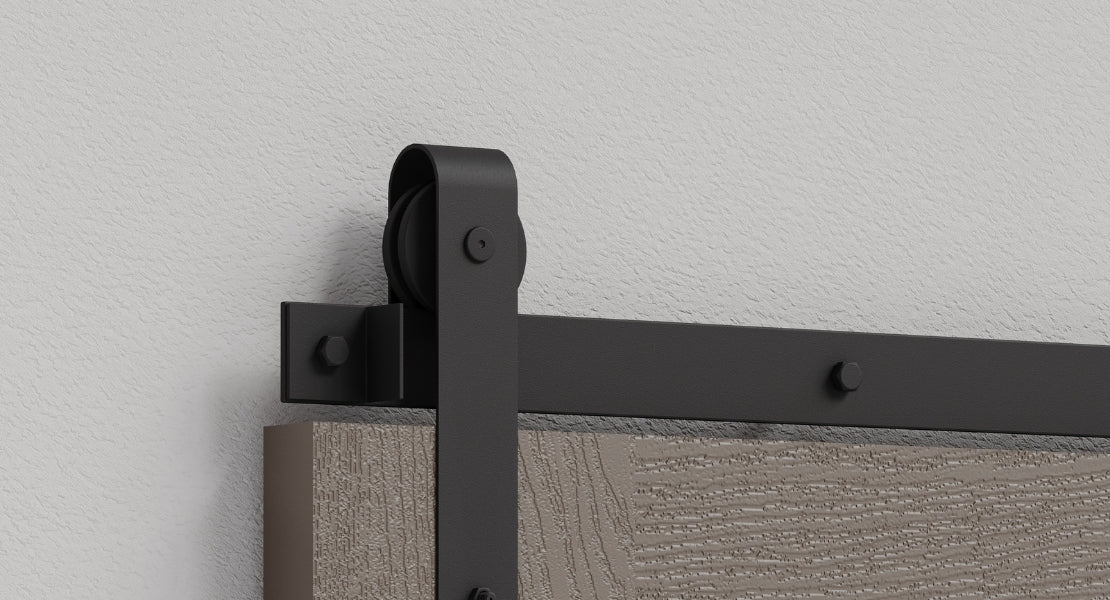
Installing Bifold Barn Doors
Bifold barn doors are a stylish and functional addition to any home. They are perfect for saving space and adding a unique touch to your interior design. In this blog post, we will guide you through the process of installing bifold barn doors.
Tools and Materials:
- Bifold barn door hardware kit
- Our bifold barn door hardware kit includes: Pre-punched track (1), track stops (2), 5ʺ hex lag bolts (3), 1ʺ spacers (3), ½ʺ spacers (6), nylon fender washers (3), fixed J-strap hanger (1), loose J-strap hanger (1), 13/4ʺ carriage bolts (6), keps nuts (6), 11/4ʺ hex bolt (1), 3/4ʺ hex bolt (1), 3/8ʺ spacer (1), flange nuts (2), hinges (4), 5/8ʺ hinge screws (16), sidewall pivot assembly (1), door bottom plate (1), 3/4ʺ steel washer (1), 15/8ʺ wood screws (4), rubber bumper band (1), clear bumper pads (6), felt strips (1), 4ʺ pull handle (1), hinge drilling template (1), door spacing template (1)
- Barn door panels
- Stud finder
- Level
- Measuring tape
- Drill
- Screws
- Pencil
- Safety glasses
Step-by-Step Instructions:
Bifold hardware can be installed so the doors stack open either to the right or to the left. You can accomplish different configurations like two doors to the left and four to the right. There are many possibilities depending on your preferences. Below we describe how to install two doors to the right.
Step 1: Drill Top of Doors
- At the top of each door panel on the end where a hanger will be attached, make a mark 11/8ʺ in from the outer end of the panel and 5/8ʺ in from the front of the panel.
- Use a 3/4ʺ bit to drill a hole 1/4ʺ deep.
Step 2: Drill Bottom of The Pivoting Door
- At the outer bottom corner of the door panel that will pivot, make a mark 11/8ʺ in from the end and 5/8ʺ in from the front.
- Use a 3/8ʺ bit to drill a hole 1ʺ deep.
Step 3: Attach the Door Bottom Plate to the Pivoting Door
- Place the 3/4ʺ×3ʺ pivot plate against the outer bottom corner of the door panel that will pivot, so the non-countersunk hole in the plate aligns with the hole drilled in step 2.
- Attach the plate with two 15/8ʺ wood screws.
Step 4: Attach Hinges to the Doors
- Place both door panels with the front sides down on a flat surface, with adjacent edges touching and tops and bottoms flush.
- Choose the three or four points where the hinges will be attached to the back of the panels. They should be approximately evenly spaced as shown.
- Insert the hinge drilling template between the panels at each point and insert the L-shaped door spacing template 3 to 5 feet away from the drilling template.
- Push both panels snugly against the two templates to keep them parallel.
- Use a 1/16ʺ bit to drill four pilot holes.
- Attach each hinge with four 5/8ʺ hinge screws.
Important: Doors more than 7 feet tall require all four hinges. For best performance, shorter doors require only three hinges.
Step 5: Drill Holes for the Hangers
- Turn over the hinged panels so the front sides are up.
- Using a hanger as a template, place it snugly on the front of each panel 3/8ʺ in from the outside edge, with the upside down swivel bolt resting in the hole drilled in step 1.
- Mark each attachment point.
- Use a 1/8ʺ bit to drill a pilot hole through the door at each marked point.
- Use a 1/4ʺ bit to enlarge the pilot holes.
Step 6: Attach the Hangers
- Use the carriage bolts and keps nuts to attach the two hangers to the doors as shown.
- The hanger with a hole below the roller goes on the pivoting door panel.
- The hanger without a hole below the roller goes on the loose (non-pivoting) door panel.
Step 7: Attach the Pull Handle
- For best performance, the included 4ʺ pull handle should be installed on the door panel with the loose (non-pivoting) hanger, with the vertical center about 35ʺ from the bottom of the panel.
- Using the pull handle as a template, mark the two attachment points as shown.
- Use a 1/8ʺ bit to drill pilot holes through the door panel at each point.
- Use a 1/4ʺ bit to enlarge the pilot holes.
- Attach the handle using the 13/4ʺ carriage bolts and keps nuts as shown.
Step 8: Mark Track Centerline
- Using a level, mark the centerline of the track on the wall. The centerline is a horizontal line at a height equal to the height of the door plus 15/8ʺ plus the desired floor gap in the range of 5/8ʺ to 11/4ʺ. (See the diagram in step 11.)
- Each end of the track must be at least 1/2ʺ away from any adjacent wall, trim or other obstruction.
- Mark the locations where the first and last lag bolts will go. With a 1/8ʺ bit, drill a pilot hole at each mark.
- Note: For a clear opening, the track should be at least 6ʺ longer than the width of the opening, overlapping the wall on the pivoting side by at least 5ʺ and the non-pivoting side by at least 1ʺ.
- For a shorter track, the stacked doors will partially occupy the opening.
Step 9: Attach the Track
- Using a 5ʺ hex lag bolt, one to three spacers and a fender washer to attach one end of the track to the wall.
- Swing the other end of the track into position and attach it to the wall.
- Mark and drill a pilot hole and repeat the process for the round hole at the center of the track.
- Note: A very short track may not have a center hole.
- Attach the track at the round holes, not the obround holes.
Step 10: Attach the Track Stop and Rubber Bumper Band
- On the loose (non-pivoting) end of the track, attach a track stop with the 1ʺ hex bolt and a flange nut as shown.
- Hand tighten for now, so it can be adjusted in step 14.
- Attach the rubber bumper band around the track stop where it will make contact with a hanger when the doors are closed.
Step 11: Install Sidewall Pivot
- Screw the aviation nut on to the pivot so that the top of the nut is slightly closer to the floor than the desired floor gap (see step 8.) It will be further adjusted in step 14.
- Place the pivot washer over the pivot and on the aviation nut.
- Using two 15/8ʺ wood screws, attach the sidewall pivot at the base of the wall as shown.
- The pivot pin should align directly below the center of the obround hole near the end of the track.
Step 12: Hang Doors on the Track
- With an assistant, lift the assembled doors and position them so that the rollers are aligned with the track and the hole in the pivot plate is above the pivot pin.
- Gently lower the doors into place, making sure that the grooves in the rollers sit correctly on the track and the pivot pin goes through hole in the pivot plate.
Step 13: Attach the Fixed Hanger Stop
- Attach the fixed hanger to the track using the 11/4ʺ hex bolt, the 3/8ʺ spacer, a track stop, and a flange nut. Hand tighten for now.
- Fold open the doors so they are stacked on the pivoting side of the opening.
- Attach an adhesive-backed felt strip to the top edge of the track as close as possible to the bottom of the loose hanger’s roller. It will create a slight bump that will help the loose hanger stay in that position.
Note: The swivel tension in either hanger can be adjusted by slightly turning the nut directly below each roller on the L-shaped base. Lighter-weight doors may need less tension than the factory setting.
Step 14: Attach the Clear Bumper Pads and Make Final Adjustments
- Fold the doors to access the hinged edges.
- Attach the 6 adhesive-backed clear bumper pads, evenly spaced along one or both inner door edges. They provide tension to help keep the doors closed.
- With a wrench, turn the aviation nut on the sidewall pivot (see step 11) so that the nut and washer are firmly against the pivot plate and the bottom of the door is high enough to clear any carpet or other floor obstruction.
- Further adjust and tighten the two track stops so that they apply enough pressure to the door assembly to keep it closed.
- The obround holes in the stops and track allow for a wide range of adjustment.
For full instructions, please see our instruction manual for bifold barn door hardware here.
Additional Tips:
- Our bifold barn door hardware kit is for 1¼ʺ to 1⅜ʺ thick doors up to 24ʺ×84ʺ with a total weight up to 125 lb. If your door is bigger, we recommend looking at our heavy duty bifold barn door hardware kit.
- Measure carefully: Accurate measurements ensure a proper fit.
Installing bifold barn doors can be a rewarding DIY project. By following these steps and using the right tools and materials, you can create a beautiful and functional addition to your home.


